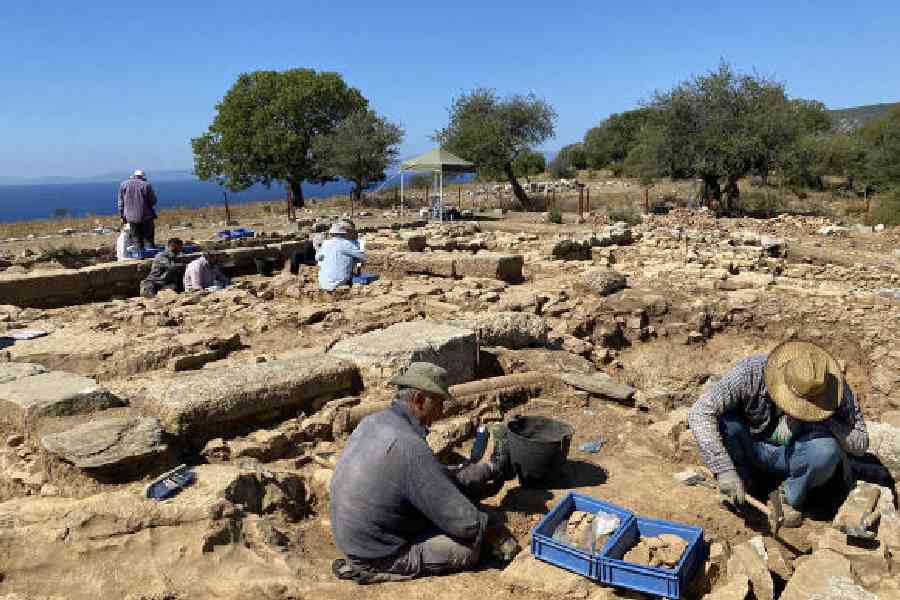It is the late 5th century BC and a mercenary kneels in his modest quarters, digging a hole in the earthen floor. He places a small jug, called an olpe, in the hole for safekeeping and covers it with dirt. In the olpe are his savings — scores of gold coins, known as darics. But something happens to the soldier and he never retrieves his hoard, which remains undiscovered for the next 2,400 years.
That is one of several scenarios proposed by Christopher Ratté, an archaeologist at the University of Michigan, US, to account for the cache, which he and his research team recently unearthed from the ruins of Notion, an ancient city-state in modern-day Turkey. While digging beneath the courtyard of a house dating to the 3rd century BC, the excavators found the remains of an earlier dwelling. “The coins were buried in a corner of the older building,” Ratté said.
Darics were used to provide payment to soldiers of fortune. Andrew Meadows, an archaeologist at the University of Oxford in the UK, said: “This is a find of the highest importance,” he said. “The archaeological context for the hoard will help us fine-tune
the chronology of Achaemenid gold coinage.”
The archaeological site at Notion spans 80 acres atop a promontory in western Anatolia, a borderland dividing Asia from Europe. It was one of the Greek-speaking communities that emerged in the region during the early first millennium BC, perhaps because of migration across the Aegean Sea. The deposition and loss of the Notion hoard occurred at a time of warfare, insecurity and great power machinations in a contested frontier zone.
Anatolia is the birthplace of the Western world’s first state-issued coin, the stater, which was created by a seafaring people called Lydians. King Alyattes standardised the weight and design of the Lydian stater, which, beginning around 610 BC, was struck in electrum, a natural alloy of gold and silver. The king’s son and successor, Croesus, is credited with minting the first true gold coin, the Croeseid.
In 546 BC, the entire area, known as Ionia, was conquered by the Achaemenid Persian Empire. Although Croesus was defeated in battle by Cyrus the Great, his gold-based monetary system lived on. The Persians continued to manufacture Croesids until they introduced their own bimetallic currency, made up of silver and gold coins. The silver coins were called sigloi, and the gold ones were darics — a name derived from either Darius I, who ruled the Persian Empire from 522 BC to 486 BC, or dari-, the root of the Old Persian word for gold.
In 427 BC, an Athenian general named Paches attacked and killed a troop of pro-Persian mercenaries at Notion after luring their commander into a trap. The Persian sympathisers were then expelled, and Notion was reorganised under Athenian supervision.
Two decades later, a naval battle in the Peloponnesian War between Athens and Sparta was fought off the coast of Notion, which the Athenians had been using as a naval base. Ratté said that the gold hoard might have been connected to the events of 427 BC, or later, with the Athenian evacuation of Notion. “It is possible it was not associated with either of these dramatic events.” he said.
In 387 BC, within a generation after the Athenians were defeated by the Spartans, Notion and the other cities of Ionia were reintegrated into the Persian Empire. They remained Persian possessions until the conquest of Alexander the Great in 334 BC, at which point production of the daric quickly declined. Alexander and his immediate successors had many of the existing gold pieces melted down and recast as coins bearing their images, making darics rare today.
The Notion darics are stamped with a likeness of the Persian king. The hoard is being stored at the Ephesus Archaeological Museum in Selcuk, Turkey.
Ratté believes the fact that the loot was never reclaimed is a sign of disaster. “No one ever buries a hoard of coins without intending to retrieve it,” he said. “Only the gravest misfortune can explain the preservation of such a treasure.”
NYTNS











